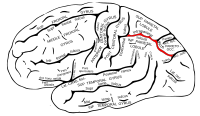Intraparietal sulcus

The intraparietal sulcus is a special part of your brain that helps you do things with your hands and understand numbers. It's like a special computer in your head that controls the movements you make with your arms and fingers, and helps you solve math problems.
But how does it work? Well, think of your brain like a big city with lots of different neighborhoods. The intraparietal sulcus is like a neighborhood that specializes in using numbers and coordinating movements. When you see something that has to do with numbers or your hands, your brain sends a signal to the intraparietal sulcus, telling it to get to work.
The intraparietal sulcus then does some really cool things. First, it helps you figure out how many things you're looking at. For example, if you see a bunch of toys on the floor, your intraparietal sulcus helps you count them and figure out how many there are.
Second, the intraparietal sulcus helps you understand the relationship between things. For example, if you're trying to fit your toy car into a tiny garage, your intraparietal sulcus helps you figure out where to move your hands to make the car fit just right.
Basically, the intraparietal sulcus is like a really smart helper that helps you do things with your hands and understand numbers. It's an important part of your brain that helps you do all sorts of things every day!
But how does it work? Well, think of your brain like a big city with lots of different neighborhoods. The intraparietal sulcus is like a neighborhood that specializes in using numbers and coordinating movements. When you see something that has to do with numbers or your hands, your brain sends a signal to the intraparietal sulcus, telling it to get to work.
The intraparietal sulcus then does some really cool things. First, it helps you figure out how many things you're looking at. For example, if you see a bunch of toys on the floor, your intraparietal sulcus helps you count them and figure out how many there are.
Second, the intraparietal sulcus helps you understand the relationship between things. For example, if you're trying to fit your toy car into a tiny garage, your intraparietal sulcus helps you figure out where to move your hands to make the car fit just right.
Basically, the intraparietal sulcus is like a really smart helper that helps you do things with your hands and understand numbers. It's an important part of your brain that helps you do all sorts of things every day!
